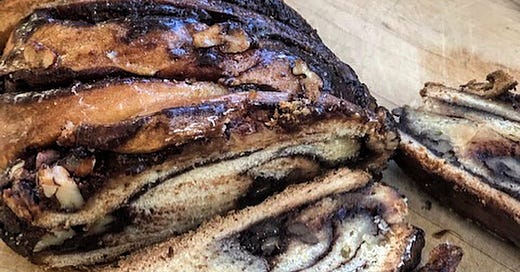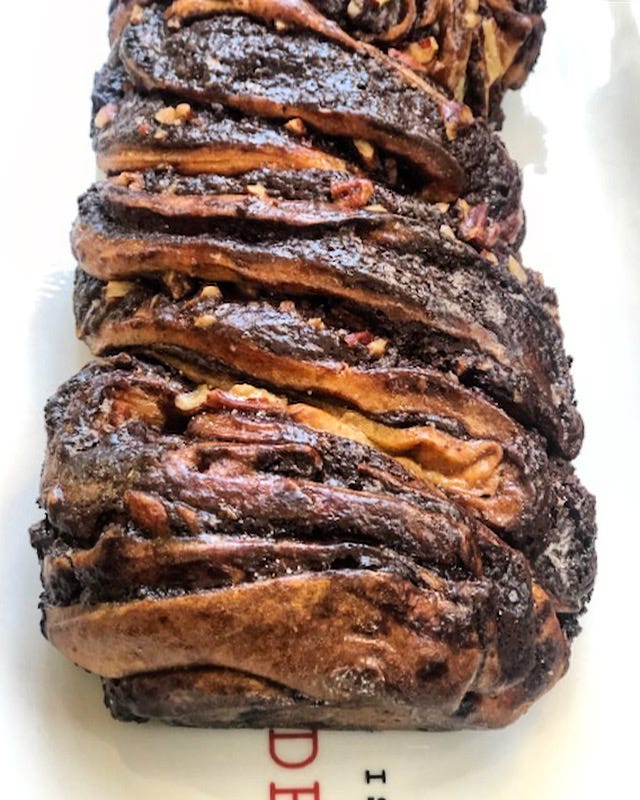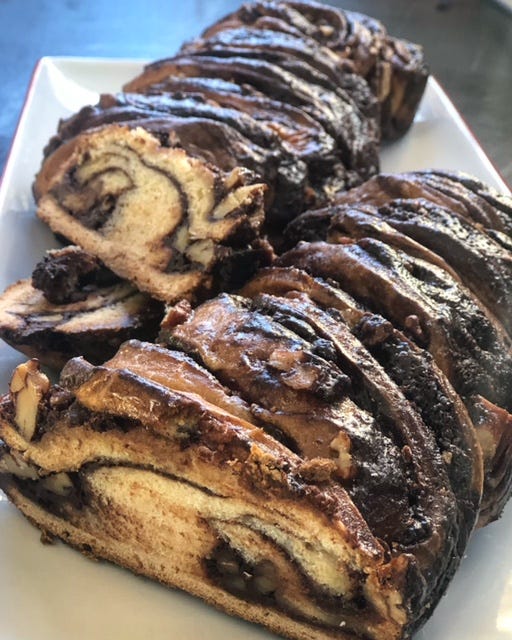Time has taken on a very curious warp and weft. Where at one time we could confidently look back on a year and recognize the threads that were shaping our lives, now the patterns are shifting, flattening, seeming to be all of a shade.
In large part that’s because we have fewer skeins in our baskets. We’re weaving experiences with a single yarn, losing the richness of multicoloured hues that bring us joy, sorrow, reflection, calm, anger, energy, fear - all in a tangled glorious pattern that we can only discern by looking back.
Finding Joy
“Joy is the holy fire that keeps our purpose warm and our intelligence aglow” - Helen Keller
I’ve been reading a lot lately about two things: finding joy and the importance of casual social connections. Although two seemingly unrelated concepts, the more I ponder them both, the more I see the brightly coloured threads that run through both. And the more I want to start weaving them back into my life.
Let’s start with joy. Joy is often conflated with happiness but in fact they’re two distinct emotions. While happiness is a state of wellbeing and contentment, joy is a burst of positivity, a moment that can be fleeting but intense in its ability to stir our emotions.
When I’m on my fourth video call of the day, I get a secret thrill of joy when I see a pair of blue jays swooping outside my window. That same rush is there when I fit in the last piece of a particularly challenging jigsaw puzzle, or when I raise the blinds in the morning to dazzling sunshine on pure white snow. There’s the joy of getting my first order from Cuddlebug, a new company my niece has started. And of course there’s always joy in the kitchen. It’s raindrops on roses and whiskers on kittens, in the best possible Julie Andrews kind of way.

And as this excellent article discusses, not only are moments of joy the important building blocks to that seemingly elusive state of happiness we all think we should be chasing - they’re also so much easier to find and weave into our lives.
The weak ties that bind and buoy us
So what about casual connections?
We’ve all been trying to stay connected to the most important people in our lives: the close family and friends we miss seeing so desperately. But deep into this severance of normal life, we’re starting to see the unintended consequences of losing the more casual connections: the people we don’t think of as friends but that form part of the pattern we weave in our day to day.
Much has been written about the Blue Zones, where residents live longer, healthier lives. Putting loved ones first and having a circle of close friends and a strong social network have been cited as key factors in that longevity. And while that inner circle sustains and nurtures us, it turns out that our relationships on the periphery have just as much impact as our closest ties.
The human moment matters
Call it the human moment at work. As Amanda Mull from The Atlantic describes, there’s a reason you miss the people you didn’t even know that well. Called “weak ties”, these lesser friendships that we’ve lost are important micro moments of connection with other humans that buoy us up - and yes, bring us joy.
I was reminded about that this morning at the farmers’ market. A far cry from the bustling scene of forever ago, with crowds and touching produce, and hugging friends, the market is now a carefully controlled, one way circuit where strangers carefully skirt away from each other as they wait to buy eggs or carrots.
At one stand, the vendor was engaged in deep conversation with a customer while I waited my turn. When she finally served me she explained that they had been chatting about birds, as the customer was very knowledgeable about them. As I left the stand I saw that same customer at the next stall.
“Excuse me. I heard that you know about birds. Can I show you a photo of a bird that I saw in my backyard this week? I’d love to know what it is.” And with that I whipped out my phone to show this perfect stranger a photo of a bird.
It’s something that I would have done countless times with countless strangers in the past, without a second thought. But as I held up my phone (a respectable distance away), and as he warily looked at me over his mask, I realised that we don’t talk to strangers anymore. After the briefest of pauses, he took a closer look. “That’s a Cooper’s Hawk,” he said. “Eats all the small birds.” He explained how I could tell what it was, its habits, that I’d probably see it again.
The conversation was all of five minutes, but for a moment in time we were two connected humans, talking about something that interested us both. We had shared a moment, and in some fragile way, a weak tie had been formed. A skein of a different colour had been woven into the fabric of my day.
So I’m resolving, not to seek that elusive bird of happiness, but to find moments of joy. And I’m hoping to re-establish more weak ties in the weeks ahead. Slowly, with patience and respect, and with the hope of weaving more human moments into this year‘s tapestry.
(For another great read on why we need sadness as well as joy, check this piece out, or even better, stream Inside Out, an excellent Pixar film that helps all of us understand the emotions controlling us. Watch it with people you love!)
Chocolate Babka (Chocolate Krantz Cake)
recipe cited from Ottolengi’s Jerusalem cookbook
Makes 2 loaves
One sure fire way to create joy is through chocolate. If you’re looking for a sweet something for your Valentine today, I’m afraid the recipe below is neither simple nor quick. But then again, why wait until Valentine’s Day for something chocolatey and delicious? Chocolate is joyful any time of the year.
INGREDIENTS:
For the dough:
4 cups / 530 g all-purpose flour, plus extra for dusting
1/2 cup / 100 g superfine sugar
2 teaspoons fast-rising active dry yeast
grated zest of 1 small lemon
3 extra-large free-range eggs
1/2 cup / 120 ml water
rounded 1/4 teaspoon salt
2/3cup / 150 g unsalted butter, at room temperature, cut into 3/4-inch / 2cm cubes
sunflower oil, for greasing
For the chocolate filling:
scant 1/2 cup / 50 g confectioners’ sugar
1/3 cup / 30 g best-quality cocoa powder
4 oz / 130 g good-quality dark chocolate, melted
1/2 cup / 120 g unsalted butter, melted
1 cup / 100 g pecans, coarsely chopped
2 tablespoons superfine sugar
For the sugar syrup (enough for both cakes):
2/3 cup / 160 ml water
1 1/4 cups / 260 g superfine sugar
DIRECTIONS:
For the dough, place the flour, sugar, yeast, and lemon zest in a stand mixer fitted with the dough hook and mix on low speed for 1 minute. Add the eggs and water and mix on low speed for a few seconds, then increase the speed to medium and mix for 3 minutes, until the dough comes together.
Add the salt and then start adding the butter, a few cubes at a time, mixing until it is incorporated into the dough. Continue mixing for about 10 minutes on medium speed, until the dough is completely smooth, elastic, and shiny. During the mixing, you will need to scrape down the sides of the bowl a few times and throw a small amount of flour onto the sides so that all of the dough leaves them. Place the dough in a large bowl brushed with sunflower oil, cover with plastic wrap, and leave in the fridge for at least half a day, preferably overnight.
Grease two 2 1⁄4-lb / 1kg loaf pans (9 by 4 inches / 23 by 10 cm) with some sunflower oil and line the bottom of each pan with a piece of waxed paper. Divide the dough in half and keep one-half covered in the fridge.
Make the filling by mixing together the confectioners’ sugar, cocoa powder, chocolate, and butter. You will get a spreadable paste. Roll out the dough on a lightly floured surface into a rectangle measuring 15 by 11 inches (38 by 28 cm). Trim the sides** to make them even, then position the dough so that a long side is closest to you. Use an offset spatula to spread half the chocolate mixture over the rectangle, leaving a 3⁄4-inch / 2cm border all around. Sprinkle half the pecans on top of the chocolate, then sprinkle over half the superfine sugar.
Brush a little bit of water along the long end farthest away from you. Use both hands to roll up the rectangle like a roulade, starting from the long side that is closest to you and ending at the other long end. Press to seal the dampened end onto the roulade and then use both hands to even out the roll into a perfect thick cigar. Rest the cigar on its seam. Trim about 3⁄4 inch / 2 cm off both ends of the roulade with a serrated knife. Now use the knife to gently cut the roll into half lengthwise, starting at the top and finishing at the seam. You are essentially dividing the log into two long even halves, with the layers of dough and filling visible along the length of both halves. With the cut sides facing up, gently press together one end of each half, and then lift the right half over the left half. Repeat this process, but this time lift the left half over the right, to create a simple, two-pronged plait. Gently squeeze together the other ends so that you are left with the two halves, intertwined, showing the filling on top. Carefully lift the cake into a loaf pan.
Cover the pan with a wet tea towel and leave to rise in a warm place for 1 to 1 and 1⁄2 hours. The cake will rise by 10 to 20 percent. Repeat the whole process to make the second cake.
Preheat the oven to 375°F / 190°C, making sure you allow plenty of time for it to heat fully before the cakes have finished rising. Remove the tea towels, place the cakes on the middle rack of the oven, and bake for about 30 minutes, until a skewer inserted in the center comes out clean.
While the cakes are in the oven, make the syrup. Combine the water and sugar in a saucepan, place over medium heat, and bring to a boil. As soon as the sugar dissolves, remove from the heat and leave to cool down. As soon as the cakes come out of the oven, brush all of the syrup over them. It is important to use up all the syrup. Leave the cakes until they are just warm, then remove them from the pans and let cool completely before serving.










What a wonderful treat (recipe and post) for these long days of isolation.
I really enjoyed reading this post with so many thoughts to ponder. Thank you for your insights and reflections. The chocolate babka is on my baking list and the Valentine's day card brought a smile to my face.